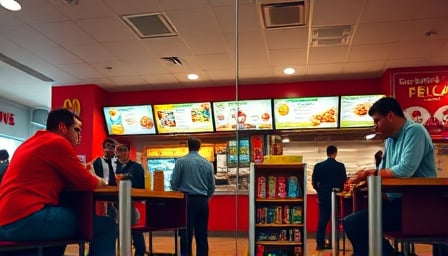Corporate News – Investigative Analysis
Restaurant Brands International Inc. (RBI) has recently adjusted the timetable for its third‑quarter earnings, now slated for release on October 30. The shift affords analysts a brief window to recalibrate expectations, yet it also raises questions about the underlying factors prompting the delay. In the same period, the company’s share price has maintained a steady stance near its 52‑week high, while a premium price‑to‑earnings (P/E) ratio indicates continued investor confidence in the firm’s valuation.
1. Earnings Rescheduling: Symptom or Signal?
The postponement of RBI’s Q3 results is noteworthy for several reasons:
| Aspect | Potential Implications |
|---|---|
| Timing | Aligns with broader industry earnings windows, possibly reducing volatility. |
| Market Reaction | Investors may interpret delay as caution, especially if prior guidance was bullish. |
| Analyst Adjustments | Adjusted earnings forecasts may affect valuation multiples. |
A deeper dive into RBI’s recent guidance suggests that the company has been navigating margin compression due to rising commodity costs, especially for oil‑based ingredients. While RBI’s management has emphasized cost‑control initiatives, the lack of a transparent disclosure on how these measures will offset the impact on gross margin warrants scrutiny.
2. Share Price Stability Amid a High P/E Ratio
RBI’s share price hovering near its 52‑week high, coupled with a P/E ratio above 30, implies that investors are willing to pay a premium for growth expectations. However, a high P/E in a cyclical sector like QSR can mask vulnerabilities:
- Competitive Pressure: Entry of new players (e.g., Banjo’s in India) dilutes market share and could erode RBI’s international growth trajectory.
- Regulatory Shifts: Emerging food‑safety and labor regulations in key markets (e.g., India, Canada) may impose compliance costs.
- Currency Volatility: RBI’s revenues are denominated in multiple currencies; sudden devaluations could compress earnings.
A scenario analysis indicates that a 10% decline in operating margin would compress the firm’s P/E to the mid‑20s, aligning it with industry peers and suggesting a more realistic valuation.
3. Emerging Competitors and Regional Dynamics
Banjo’s Expansion in India
Banjo’s ambitious plan to open 500 outlets by 2028 reflects a strategic bet on India’s expanding fast‑food market. Key observations include:
- Market Share Impact: RBI’s current footprint in India is modest (~30 outlets). Banjo’s rapid scaling could capture a significant portion of the nascent QSR segment, especially among price‑sensitive consumers.
- Supply Chain Advantages: Banjo’s local sourcing model may offer cost advantages that RBI’s global supply chain cannot easily replicate.
- Brand Positioning: While RBI’s flagship brands are globally recognized, Banjo’s homegrown branding could resonate more strongly with Indian consumers seeking localized experiences.
Macro-Level Trends
- Urbanization & Digital Ordering: The growth of e‑commerce platforms and delivery apps in India is accelerating demand for convenient, low‑price meal options—areas where Banjo’s and other local brands excel.
- Regulatory Landscape: RBI has faced scrutiny over labor practices in Canada. Similar regulatory scrutiny could arise in India, potentially affecting operational costs for all QSR operators.
4. Comparative Industry Movements
Other players in the food sector are leveraging seasonal marketing and expansion strategies:
- Marco’s Pizza: Capitalizing on National Pizza Month, the company’s promotional activities are expected to drive short‑term revenue spikes. However, such campaigns are unlikely to materially affect RBI’s valuation, given the segment’s limited overlap.
- Natuf Café: Positioning itself to ride India’s QSR boom, Natuf’s strategy mirrors Banjo’s but at a smaller scale. Its aggressive growth could indirectly influence consumer expectations of pricing and quality within the broader market.
While these developments are peripheral, they illustrate a broader industry momentum toward rapid geographic expansion and aggressive marketing—strategies that RBI must monitor to avoid being outpaced in high‑growth regions.
5. Risk Assessment and Opportunities
| Risk | Impact | Mitigation |
|---|---|---|
| Margin Compression | Earnings dilution | Cost‑control, menu optimization |
| Competitive Expansion | Loss of market share | Accelerate regional store openings, local menu adaptation |
| Regulatory Compliance | Increased costs | Proactive engagement with regulators, ESG initiatives |
| Currency Fluctuations | Earnings volatility | Hedging strategies, diversified currency base |
Conversely, opportunities exist:
- Digital Innovation: Investing in AI‑driven ordering systems can improve margins.
- International Partnerships: Joint ventures in emerging markets could accelerate entry while sharing risks.
- Sustainability Initiatives: Green packaging and local sourcing can enhance brand perception and attract premium pricing.
6. Conclusion
RBI’s recent actions—a deferred Q3 earnings release, a stable yet premium stock valuation, and a competitive environment characterized by aggressive local expansion—present a nuanced picture. Investors and analysts should:
- Re‑examine Valuation Models to account for potential margin erosion and competitive pressure.
- Monitor Regional Growth Initiatives, especially in India, to gauge how local entrants might alter RBI’s long‑term revenue streams.
- Track Regulatory Developments, as emerging food‑safety and labor laws could materially affect operating costs.
By maintaining a skeptical yet informed stance, stakeholders can better anticipate where RBI’s strategic choices will either fortify its market position or expose it to heightened risk.
